重庆代孕█微信:138-0226370█重庆代孕价格多少█微信:138-0226-9370█重庆代孕费用多少█微信:138-0226-9370█
1、JDK的版本
(1) jdk1.7常见的新特性
① switch支持String(原本只支持byte、short、char、int)
(2) Jdk1.8常见的新特性(myelipse10/2014不支持jdk1.8)
① 使用default修饰词为接口添加非抽象方法
1. public interface NewCharacter {
2.
3. public void test1();
4.
5. public default void test2(){
6. System.out.println("我是新特性1");
7. }
8.
9. }
② 添加了lambda表达式(常用的使用方式 (x,y) ->System.out.println(x+","+y); )
③ 添加了foreach方法
④ 添加了stream方法(以下为②③④综合例子)
1. public class StreamExample {
2.
3. public static void main(String[] args) {
4.
5. List<Integer> myList = new ArrayList<>();
6. for(int i=0; i<100; i++) myList.add(i);
7.
8. //有序流
9. Stream<Integer> sequentialStream = myList.stream();
10.
11. //并行流
12. Stream<Integer> parallelStream = myList.parallelStream();
13.
14. //使用lambda表达式,过滤大于90的数字
15. Stream<Integer> highNums = parallelStream.filter(p -> p > 90);
16. //lambdag表达式 forEach循环
17. highNums.forEach(p -> System.out.println("最大数 并行="+p));
18.
19. Stream<Integer> highNumsSeq = sequentialStream.filter(p -> p > 90);
20. highNumsSeq.forEach(p -> System.out.println("最大数 有序="+p));
21.
22. }
23.
24. }
输出结果
1. 最大数 并行=91
2. 最大数 并行=96
3. 最大数 并行=93
4. 最大数 并行=98
5. 最大数 并行=94
6. 最大数 并行=95
7. 最大数 并行=97
8. 最大数 并行=92
9. 最大数 并行=99
10. 最大数 有序=91
11. 最大数 有序=92
12. 最大数 有序=93
13. 最大数 有序=94
14. 最大数 有序=95
15. 最大数 有序=96
16. 最大数 有序=97
17. 最大数 有序=98
18. 最大数 有序=99
https://blog.csdn.net/dounine/article/details/70546625
2、基本数据类型和运算过程
(1) 八大基本数据类型:byte(1字节),short(2字节),int(4字节),long(8字节).float(4字节),double(8字节),char,boolean(1位)(1字节=8位)
char的字节:
char使用unicode存储字符,如果是utf-16,则为2字节,如果是utf-8,则为1到4字节,中文一般为3字节
(2) 赋值、算术、关系、逻辑、位运算、条件运算
① 自增,自减
int a = 1;
int sum = (a++) + (++a) + (a--) + (++a) + (a++) + (--a) + (a++);//19
② &和&&的区别
都可以做逻辑运算符,&无论第一个表达式是否为true,都会判断第二个表达式,&&当第一个表达式是false,则第二个表达式不会判断,&还可以做位运算符
③ 运算符的优先级
算术>关系>逻辑
+- >< &!|
3、枚举
1. public enum EnumDemo {
2. SPRING(1, "春季"), SUMMER(2, "夏季"), AUTUMN(3, "秋季"), WINTER(4, "冬季");
3.
4. private final int code;
5. private final String value;
6.
7. private EnumDemo(int code, String value) {
8. this.code = code;
9. this.value = value;
10. }
11.
12. public static void show() {
13. System.out.println("枚举的键\t枚举的值\t枚举的名字\t枚举的下标");
14. for (EnumDemo enumDemo : EnumDemo.values()) {
15. System.out.print(enumDemo.code+"\t");
16. System.out.print(enumDemo.value+"\t");
17. System.out.print(enumDemo.name()+"\t");
18. System.out.println(enumDemo.ordinal());
19. }
20. }
21. }
https://blog.csdn.net/jaafar_1024/article/details/76242205
4、String
(1) String常用方法
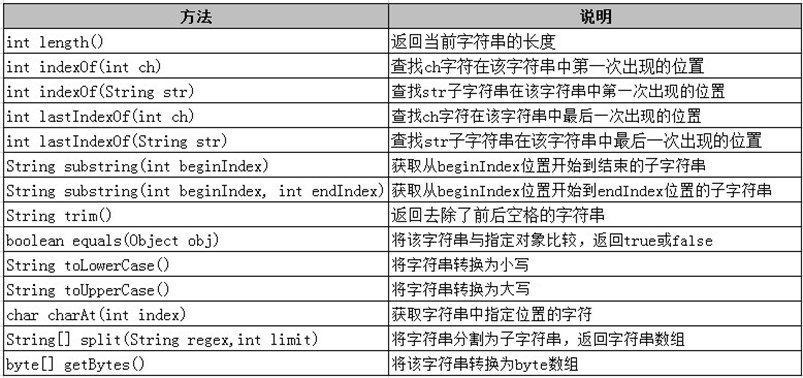
来自慕课网
① ==和equals的区别
如果没有重写equals方法==和equals都是比较地址,重写了equals方法则equals方法比较的是对应地址的值,基本数据类型使用==比较,java中String和包装类默认重写了equals方法。
(2) StringBuilder(速度快) 或 StringBuffer(线程安全)
Reverse方法:倒序,在原有的基础上倒序,无返回值

① String和StringBuilder、StringBuffer三者的区别
String是final修饰的不可变的,对String的任何改变产生一个新的String,占空间,StringBuilder和Stringbuffer是可变的,修改会在原有的基础上变动,StringBuilder线程不安全,运行速度较快,Stringbuffer线程安全,运行速度较慢。
String重写了equals方法,StringBuffer和Stringbuilder没有。
(3) String的堆栈
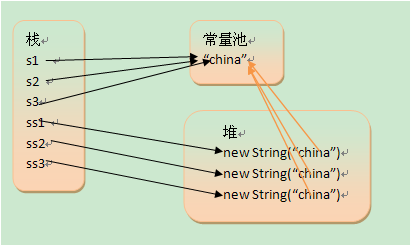
常量池中一个对象,堆中三个对象,一共四个对象
https://blog.csdn.net/LK274857347/article/details/77512555
(4) String和基本数据类型、包装类互换
① 包装类与基本数据类型自动装拆箱(int初始值为0,integer为null)
② 转化为String
提示:还可以使用对应包装类的toString方法,推荐valueOf:
效率最高,可以转化char数组、toString不行,
每种数据都是使用String不用找各种包装类的对应类,整齐
1. int a = 1;
2. Integer b = 1;
3. char c = '1';
4. Character d = '1';
5. char[] e = { 'a', 'b', 'c' };
6. String string1 = String.valueOf(a);// int转化为String
7. String string2 = String.valueOf(b);// int包装类转化为String
8. String string3 = String.valueOf(c);// char转化为String
9. String string4 = String.valueOf(d);// char包装类转化为String
10. String string5 = String.valueOf(e);// char数组转化为String
③ String转化为基本数据类型和包装类
1. String s = "1234";
2. // parseInt返回的是int,valueOf和构造函数返回是Integer,自动装拆箱后没有区别
3. Integer i1 = Integer.parseInt(s);
4. Integer i2 = Integer.valueOf(s);
5. Integer i3 = new Integer(s);
6. // charAt返回坐标为1对应的字符,indexOf返回符文为1对应的下标,toCharArray()返回char数组
7. char c1 = s.charAt(1);
8. char c2 = (char) s.indexOf("1");
9. char[] c3 = s.toCharArray();
10. System.out.println(c1);
5、数组
(1) 常见方法
Arrays.
sort();升序;
equals(a,b);比较
toString(a);输出字符串
fill(a,4);所有元素换成4
copyOf(a,4);复制出一个新的数组,长度变成4
binarySeatch(a,4);查询4在数组a中下标多少
asList(list);数组转化为list
(2) 冒泡排序
for(i<N-1){for(j<N-i-1){交换位置}}
6、集合
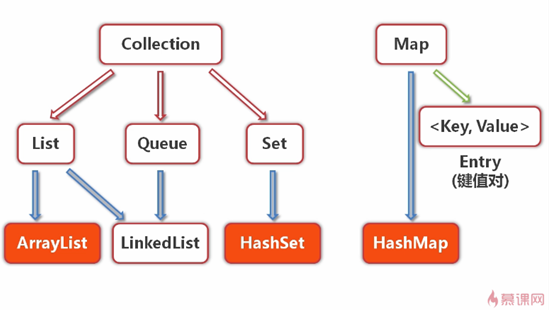
(1) 基本知识
① Collection、List、Set、Map都是接口无法实例对象
② 常见集合简介
1) ArrayList有序,可重复,查询速度快,数组方式
2) LinkedList有序,可重复,插入数据快,链表方式
3) HashSet无序,不可重复,散列表方式
4) HashMap无序,key不可重复,value可重复,线程不安全,效率较快,key可以有一个null
5) HashTable无序,key不可重复,value可重复,线程安全,效率较慢,key不能为null
(2) ArrayList(HashSet方法一样)
1. List<String> list = new ArrayList<String>();
2. list.add("one");
3. list.add("two");
4. list.add("three");
5. list.remove("two");
6. boolean flag = list.contains("one");// 集合中是否存在"one"
7. boolean flag1 = list.isEmpty();// 集合是否为空
8. System.out.println(list.size());//长度为2,数组用length,String用length(),集合用size()
9. Iterator iterator = list.iterator();
10. while (iterator.hasNext()) {
11. System.out.println(iterator.next());// 输出one three
12. }
13. System.out.println(flag + "," + flag1);// true,false
(3) HashMap
1. Map<Integer, String> map = new HashMap<Integer, String>();
2. map.put(1, "one");
3. map.put(2, "two");
4. map.put(3, "three");//put可以添加也可以修改
5. map.get(1);// 根据键得到值
6. Set<Integer> set = map.keySet();// 获得键的set集合
7. Iterator<Integer> iterator = set.iterator();
8. //迭代器有什么用,我感觉for更好用,求回答
9. while(iterator.hasNext()){
10. System.out.println(iterator.next());// 1 2 3
11. }
12. List<String> list = new ArrayList<String>(map.values());
13. //这里用迭代器报错,不知道为什么只能用for了
14. for(String str:list){
15. System.out.println(str);// one two three
16. }
7、流程控制
(1) 选择结构:if else switch(){case 常量: break;}
(2) 循环结构:while do{}while(); for()
(3) 循环四个要素:开始、条件、循环体、循环退出
(4) 控制循环的关键字
① continue:跳过一次循环
② break:跳出循环
③ return:返回值跳出方法
④ System.exit(0):系统正常退出,1为非正常退出
8、修饰词
(1) 访问修饰符:
① private 本类
② 默认 本包
③ protected 本包及其子类
④ public 公共的
(2) 其他修饰词
① static 类共有的属性和方法
1) 单例模式
a. 恶汉模式
1. public class Singleton {
2.
3. private final static Singleton INSTANCE = new Singleton();
4.
5. private Singleton(){}
6.
7. public static Singleton getInstance(){
8. return INSTANCE;
9. }
10. }
b. 懒汉模式
1. public class Singleton {
2.
3. private static Singleton singleton;
4.
5. private Singleton() {}
6.
7. public static synchronized Singleton getInstance() {
8. if (singleton == null) {
9. singleton = new Singleton();
10. }
11. return singleton;
12. }
13. }
c. 内部类
1. public class Singleton {
2.
3. private Singleton() {}
4.
5. private static class SingletonInstance {
6. private static final Singleton INSTANCE = new Singleton();
7. }
8.
9. public static Singleton getInstance() {
10. return SingletonInstance.INSTANCE;
11. }
12. }
② final 修饰变量时引用不可变,值可变,修饰方法时方法不可重写,修饰类时方法不能被继承
//finally异常处理的一部分,除了System.exit(0/1)必被执行
//finalize类被垃圾收集器回收时执行的方法
③ synchronized 线程同步
(3) 抽象和接口
共同点:有抽象方法一定是抽象类或者接口,都不能实例对象
不同点:抽象类的修饰符没有限制,抽象类中可以有0到多个抽象方法,类继承抽象类时只能继承1个,接口的变量修饰词固定为public static final,方法固定为public abstract ,jdk1.8后可以使用default增加非抽象方法,类实现接口时可以实现多个
9、封装、继承、多态
(1) 封装
① 步骤:私有化属性,生成属性的setter/getter方法,在方法中加入限制...
② 意义:提高代码的安全性
(2) 继承
① 步骤:新建类时使用extends继承一个类,使用implements实现多个接口
② 意义:提高代码重用性
(3) 多态
① 体现:体现在方法重载和重写中,重写的返回值类型、参数必须与父类相同或者是其子类
② 意义:编程时引用对象无法确定类型,运行时才确定引用对象的类型时使用,提高代码的灵活性和扩展性
1) 重载和重写的区别
重载和重写的方法名必须相同,重载在一个类中,重写在有继承关系的两个类中
重载只与参数类型有关,参数类型或者个数必须不同
重写的访问修饰符不能严于父类,返回值类型、参数必须与父类相同或者是其子类。
重写不能抛出比父类更多的异常。
10、异常
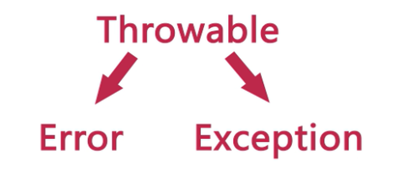
(1) Error是虚拟机错误、线程死锁等,程序员无法解决
(2) Exception 分为编译异常和运行时异常
① 编译异常
② 运行时异常(RuntimeException)
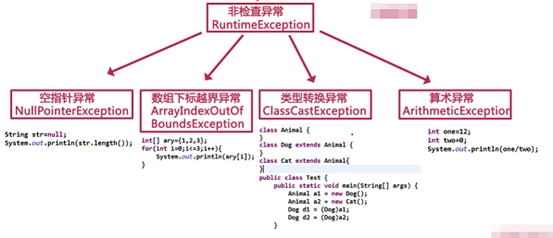
//破解office2016
https://jingyan.baidu.com/article/59a015e352f275f794886598.html
//使用word上传博客
https://www.cnblogs.com/ywhyme/p/7744393.html
//第一次写博客,可能会有很多错误,望指出,看过的记得扣1,让我知道有人看过0.0